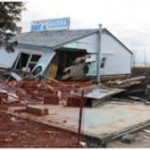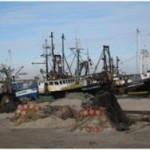Social Scientists Dig Into Superstorm Sandy’s Long Term Effects on Coastal Fishing Communities
from The Fishing Wire
Within weeks of Superstorm Sandy’s devastating landfall in New York and New Jersey, NOAA Fisheries social scientists were on the scene to evaluate the damage to local economies that rely on fisheries. Overall, results showed that these communities in both New Jersey and New York incurred sizable losses and that the majority of these losses were uninsured, but researchers wanted to know more.
“We helped to conduct hundreds of interviews in dozens of communities in coastal areas most affected by the storm,” says Lisa Colburn, a social scientist at NOAA Fisheries Northeast Fisheries Science Center, who helped lead the effort. “We compared pre-storm conditions with those in the four weeks after the storm. It was pretty hectic, and we didn’t want to make life harder for these traumatized communities, but we could already see the value in extending this work to look at longer term effects.”
Since the rapid response assessment, Colburn and her colleagues at the NOAA Fisheries Northeast Fisheries Science Center — Patricia Clay, Tarsila Seara and Angela Silva – have continued the work they started in the rapid assessment. They have looked more broadly at the importance and distribution of commercial and recreational fishing communities in both New York and New Jersey, and at changes in species landed since the storm. In collaboration with Rutgers University and with funding from the National Science Foundation, they have looked at resilience to the storm’s effects among fishermen and their families.
Superstorm Sandy damage at Shinnecock, N.Y. commercial dock . Photo credit: Angela Silva, NEFSC/NOAA.
A full report looking at recovery in the nine months after Sandy will be available by December. Preliminary results show clear differences in the volume and kinds of commercial landings after Sandy when compared with catches during the five years prior to Sandy. The number of recreational trips for shore, private/rental boat and for-hire vessels showed similar differences. Results from the collaborative study with Rutgers show a range of effects within all the categories of commercial fishermen, fish dealers, for-hire recreational fishing business owners, bait and tackle shop operators, and marina operators. These are strongest immediately after the storm for everyone, but rates and levels of recovery vary.
Beginning in 2014, the effort will ratchet up a notch as a large-scale survey is implemented to better quantify long- term effects and barriers to recovery. Commercial fishermen, fish dealers, for-hire recreational fishing business owners, bait and tackle shop operators, marina operators, and aquaculturists in the two states are among the survey targets. Researchers will be asking about the condition of businesses, communities, and personal well-being and use a variety of methods to measure and report on these aspects of the storm’s effects.
These data, and analyses of other ongoing work on social impacts, will form the basis of a detailed report expected in 2014 covering change after one year, post-Sandy. Patricia Clay, Colburn’s colleague and co-author, says looking at long-term recovery patterns after disasters that disrupt fishing communities is a relatively new research area. “By systematically talking with people who have been most affected we not only gather hard data about economic and social conditions, but also create a way to ground-truth and interpret the quantitative data such as those on landings and employment, ” says Clay. “If we can bring those two pieces together, it would be a big step forward in understanding the factors that influence resiliency in these communities in the face of change.”
Contact: Teri Frady, NOAA

